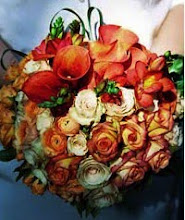So, what is an example of a traditional wedding flower technique? One of the most used is what I would call the "wire and tape" method. In the past was a limited list of flowers that were typically used in bridal bouquets. Orchids, Stephanotis, Lily of the Valley, carnations and to some extent roses. Most of these flowers were usually available year round. Since the oasis filled bouquet holder had not been invented yet (the holder came into use in the late 1960's), most florists constructed their bouquets by wiring and taping each flower and joining them continually until the bouquet achieved a cascade or round nosegay shape. Often the more delicate flowers like Lily of the Valley and Stephanotis were hard to find in out of season months, so silk or cloth (artificial) forms of these flowers were added. Also popular in the 40's, 50's, and 60's were the addition of puffs of tulle, sprays of seed pearls and ribbon... lots and lots of ribbon. Typically too, most bridal bouquets contained only white flowers, going along with the general theme of white for purity for all things bridal. Another aspect of having a bouquet of this construction was that after the flowers were wilted, dried and gone there was still much of the bouquet left over in ribbon, wire, tulle, and other decorative trinkets. We at Down the Isle like the idea of having mementos of the special day left over, a keepsake for many years to come.
Pictured here is my mother's bouquet, as it was placed on the cake table at her wedding reception in November, 1964. Her bouquet was wire, tape, ribbon, tulle, pearls, cloth Lily of the Valley, white Fuji mums, and a center focal point of a Cymbidium orchid corsage (more on the corsage in the the bouquet in a later post). Her bouquet, after being caught by my aunt at the reception, spent the next 30 years or so in the original florist's box it was delivered in. Over the years the flowers disappeared and the ribbon and tulle became fragile, but there was much leftover, and it was evident that it had been a bridal bouquet.



No comments:
Post a Comment